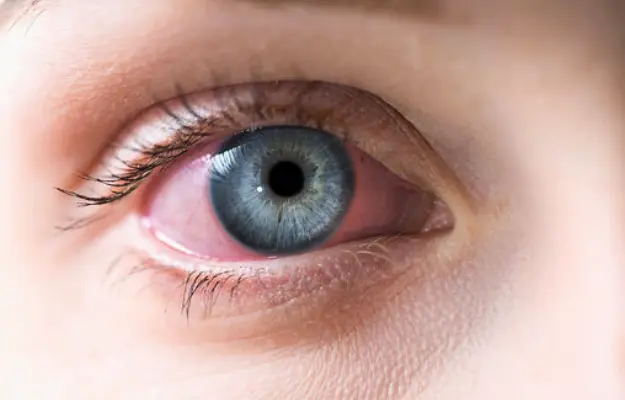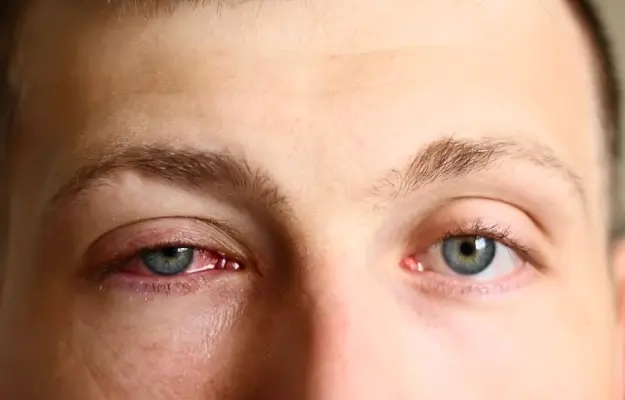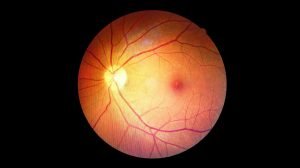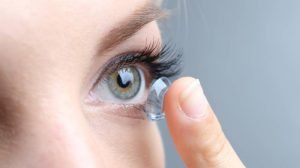Are your eyes suddenly bloodshot, itchy, constantly tearing, and producing discharge? You might be suffering from red eye – a very common acute eye infection, especially during epidemic seasons. While usually not dangerous to vision, red eye spreads extremely quickly and causes considerable discomfort, affecting daily life, studies, and work.
Equipping yourself with solid knowledge about what red eye is, common causes of red eye, typical red eye symptoms, especially how red eye spreads, and effective prevention measures is crucial to proactively protect yourself, your family, and the community.
This article will be a comprehensive guide to red eye, leading you to explore every aspect of the condition. We will learn how to recognize early signs of red eye, its causal factors, effective at-home red eye treatment methods and when to see a doctor, as well as essential red eye prevention tips to keep your eyes healthy.
What is Red Eye?
Red eye (conjunctivitis) is an inflammation of the transparent membrane (conjunctiva) that covers the white part of the eye and the inner surface of the eyelids. When the conjunctiva becomes inflamed, the small blood vessels within it swell and become more visible, giving the white of the eye a red or pink color, hence the common name “red eye.”
Nature of the red eye condition:
- Not always serious: Most cases of red eye are benign and can resolve on their own within 1-2 weeks.
- Highly contagious: This is a key point to note. Red eye spreads very quickly through direct or indirect contact, especially in group settings.
Common types of red eye:
- Viral Red Eye:
- Causes: Often caused by Adenovirus, Herpes simplex virus, or other viruses. This is the most common and most contagious type.
- Symptoms: Red eyes, excessive tearing, possibly accompanied by swollen lymph nodes in the ear and throat (especially in children), and cold or flu-like symptoms. Usually, there is no thick pus.
- Bacterial Red Eye:
- Causes: Commonly caused by Staphylococcus aureus, Streptococcus pneumoniae, or Haemophilus influenzae.
- Symptoms: Red eyes, abundant yellow or greenish discharge (pus), often causing eyelids to stick together in the morning. Redness and swelling can be more severe.
- Allergic Red Eye:
- Causes: Due to the body’s reaction to allergens such as pollen, pet dander, dust, chemicals, or cosmetics.
- Symptoms: Severe eye itching, redness, clear watery discharge, swollen eyelids. Usually affects both eyes and may be accompanied by other allergic symptoms like sneezing and runny nose.
- Chemical or Foreign Body Red Eye:
- Causes: Eye contact with harmful chemicals, dust, or foreign objects flying into the eye.
- Symptoms: Redness, tearing, burning sensation. Eyes should be rinsed immediately, and a doctor consulted if the condition does not improve.
Understanding the classification helps in identifying the cause of red eye and choosing the appropriate effective red eye treatment.
>> Read more: A Guide to Identifying and Managing Common Eye Diseases
Causes of Red Eye: Why Do Your Eyes Become Inflamed and Red?
Red eye is a result of an inflammatory or allergic reaction of the conjunctiva. To effectively prevent red eye and treat red eye, it is crucial to understand its causes.
The main causes of red eye include:
- Viruses (Most common):
- Adenovirus: Accounts for the majority of infectious red eye cases, especially during outbreaks. This virus is highly contagious through respiratory droplets and direct contact.
- Herpes Simplex Virus: Can cause red eye accompanied by small blisters on or around the eyelids, which can be more severe.
- Other viruses: Such as measles or chickenpox viruses.
- Bacteria:
- Staphylococcus aureus: Bacteria commonly found on the skin, which can cause infection under favorable conditions.
- Streptococcus pneumoniae: Causes upper respiratory tract infections and can also lead to red eye.
- Haemophilus influenzae: Particularly common in children.
- Neisseria gonorrhoeae (gonorrhea) or Chlamydia trachomatis: Can cause severe red eye in newborns due to maternal transmission, or in adults through sexual contact.
- Allergens:
- Pollen, pet dander, dust, mold: Cause allergic reactions upon eye contact.
- Eye cosmetics, household chemicals, eye drops: Some individuals may be allergic to components in these products.
- Irritants and Foreign Bodies:
- Smoke, dust, air pollution: Cause eye irritation.
- Chlorine in swimming pools: Can cause chemical conjunctivitis.
- Foreign objects in the eye: Dust, sand, small insects.
- Contact lenses: Improper use, poor hygiene, or wearing them for too long.
Understanding the causes of red eye will help you implement appropriate prevention and red eye treatment measures.
Recognizing Red Eye
Early recognition of red eye symptoms is extremely important for timely isolation, red eye treatment, and prevention of spread. Here are the most typical red eye symptoms you should look out for:
- Red eyes: This is the most obvious red eye symptom, due to swollen blood vessels in the conjunctiva. The eyes can appear pinkish or bright red.
- Itching, burning, gritty sensation: A persistent uncomfortable feeling as if there is dust or sand in the eye, prompting a constant desire to rub.
- Tearing: Eyes produce more tears than usual, especially when exposed to light or wind.
- Discharge (mucus/pus): Discharge can be white, yellow, or greenish, depending on the cause of red eye. It is often abundant in the morning, causing eyelids to stick together and making it difficult to open the eyes.
- Swollen eyelids: Eyelids may be mildly or significantly swollen, especially if the red eye is due to allergies.
- Light sensitivity (photophobia): Feeling uncomfortable when looking at bright light.
- Temporary blurred vision: Vision may be slightly affected, feeling unclear, especially when there is a lot of discharge.
When to be cautious and see a doctor immediately?
Although most cases of red eye are not serious, there are some dangerous warning signs indicating that you should see an ophthalmologist as soon as possible:
- Severe eye pain: The eye pain does not subside, or even intensifies.
- Sudden vision loss or blurriness: Not due to discharge, but a significant reduction in vision even after blinking.
- Extreme light sensitivity (severe photophobia): Eyes are very uncomfortable or painful when exposed to any light source, even dim light.
- Severe or worsening redness: The entire white of the eye is dark red, or the redness does not improve after a few days of home treatment.
- Damage to the cornea (black part of the eye): For example, white spots or cloudiness on the cornea.
- Red eye symptoms do not improve after 3-4 days of home treatment.
- You have a weakened immune system (e.g., taking immunosuppressants, HIV) or wear contact lenses.
- Red eye in newborns: This is an emergency and requires immediate medical attention from a doctor, as it can be due to severe infection.
If you or your loved one has any of the dangerous warning signs above, visit a hospital or eye clinic for an accurate diagnosis and timely red eye treatment.
How Does Red Eye Spread? Effective Ways to Prevent Infection
Red eye is a highly contagious disease that spreads quickly and widely, especially in crowded environments such as schools, offices, and hospitals. Understanding how red eye spreads is a crucial factor in implementing effective infection prevention methods.
Red eye primarily spreads through the following routes:
- Direct Contact:
- Eye discharge: When an infected person touches their diseased eye, then touches another person (shaking hands, hugging).
- Sneezing, coughing: Droplets from an infected person’s respiratory tract can contain viruses and enter a healthy person’s eyes.
- Infected tears: Direct contact with an infected person’s tears.
- Indirect Contact with Contaminated Surfaces:
- Touching shared objects: Doorknobs, desks, phones, TV remotes, computers, toys, personal items (towels, pillows, eyeglasses, eye drops…). Pathogens can survive on these surfaces for several hours.
- Sharing personal items: Especially face towels, washbasins, pillows, swimming goggles, eye makeup.
How long can red eye pathogens survive?
The viruses or bacteria that cause red eye can live on surfaces and objects for several hours to several days, depending on the type of pathogen and environmental conditions. This explains why the disease can spread rapidly even without direct contact.
Effective ways to prevent infection:
To prevent red eye from spreading, apply the following measures:
- Wash hands frequently and properly: Wash hands with soap and clean water (for at least 20 seconds) or an alcohol-based hand sanitizer (at least 60% alcohol) after touching your eyes, before eating, after using the restroom, and after touching public surfaces.
- Absolutely do not touch your eyes: Avoid rubbing your eyes or touching them with unwashed hands.
- Limit close contact: Avoid hugging, kissing, shaking hands, or sharing items with someone who has red eye.
- Isolate infected individuals: People with red eye should stay home from school/work during the acute phase of the illness (usually 7-10 days) to prevent spreading it to others.
- Do not share personal items: This includes face towels, bath towels, pillows, eyeglasses, contact lenses, swimming goggles, eye makeup. Use a separate face towel.
- Clean living environment: Regularly wipe and disinfect frequently touched surfaces such as doorknobs, tables, phones, and remote controls with disinfectant solutions.
- Change pillowcases and bed sheets frequently: Wash with hot water to kill pathogens.
- Use separate tissues/clean cloths when wiping eyes: Discard immediately after use.
- Do not go swimming while ill: Avoid spreading pathogens in the water.
Implementing these effective infection prevention methods will help keep you and your community safer from red eye.
Effective Red Eye Treatment
Effective red eye treatment depends on the cause of red eye (viral, bacterial, allergic). However, there are some general principles and care steps you can take.
Home care for red eye (Applicable to all types of red eye)
- Clean eyes thoroughly: Use a clean cotton ball or medical gauze soaked in saline solution (0.9%) to gently wipe from the inner corner of the eye outwards to remove discharge and clean the eye. Use a fresh piece of cotton/gauze for each wipe. Do this 3-4 times a day or whenever discharge is present.
- Warm/cold compress:
- Warm compress: Use a clean cloth or gauze soaked in warm (not hot) water and place it over the eye for a few minutes to soften discharge and reduce discomfort.
- Cold compress: Use a cold cloth or cold gel pack over the eye to reduce swelling and itching, especially effective for allergic red eye.
- Rest and limit eye strain: Avoid prolonged reading, watching TV, using phones, or computers. Get enough sleep to allow your eyes to rest.
- Do not self-medicate with corticosteroid eye drops: This type of medication can worsen the condition if the red eye is caused by the Herpes virus or fungus.
- Do not attempt to squeeze or pick at discharge: This can damage the eye.
Medical intervention (When to see a doctor and treatment methods)
You should see an ophthalmologist if your red eye does not improve after 3-4 days of home care, or if you experience any of the dangerous warning signs mentioned above. The doctor will accurately diagnose the cause of red eye and provide an appropriate treatment plan:
- Viral Red Eye:
- Often no specific treatment, the condition will resolve on its own in 1-2 weeks.
- The doctor may prescribe artificial tears to relieve dry eyes and discomfort, or antibiotic eye drops to prevent secondary bacterial infection.
- In some severe cases caused by the Herpes virus, antiviral medication will be prescribed.
- Bacterial Red Eye:
- The doctor will prescribe antibiotic eye drops or ointment. You must strictly follow the dosage and duration of use, even if symptoms have improved, to prevent relapse or antibiotic resistance.
- Allergic Red Eye:
- Avoid allergens.
- The doctor will prescribe anti-allergic eye drops (antihistamines, mast cell stabilizers) or low-dose corticosteroid eye drops (under supervision).
- Oral antihistamines may be used if there is systemic allergy.
- Chemical/Foreign Body Red Eye:
- Immediately rinse the eye with clean water or saline solution for at least 15-20 minutes.
- Go to a medical facility immediately for a doctor to examine, remove the foreign body, and assess damage.
Always follow your doctor’s advice for the most effective and safest red eye treatment.
>> Read more: Effective Treatment of Blepharitis with BlephEx
How to Prevent Red Eye
Red eye is highly contagious, so effective red eye prevention plays a crucial role in protecting your and your family’s eye health, especially during epidemic seasons.
- Wash hands frequently and properly: This is the most important prevention measure. Wash hands with soap and clean water for at least 20 seconds, especially after contact with an infected person, touching public surfaces, or after using the restroom. Keep an alcohol-based hand sanitizer for use when water is not available.
- Absolutely do not touch your eyes: Avoid the habit of rubbing your eyes or touching them with unwashed hands.
- Do not share personal items:
- Face towels, bath towels: Each person should have their own towel and wash it regularly.
- Pillows, bed sheets: Wash thoroughly and dry in the sun periodically.
- Eyeglasses, contact lenses, swimming goggles: Do not share.
- Eye makeup: Do not share mascara, eyeliner, or eyeshadow.
- Clean living and working environments:
- Regularly wipe and disinfect high-touch surfaces such as doorknobs, tables, phones, and remote controls with disinfectant solutions.
- Pay special attention to hygiene in schools, daycare centers, and offices.
- Limit close contact with sick individuals:
- Avoid hugging, kissing, or shaking hands with people who have red eye.
- If a family member is infected, temporary isolation is recommended, using a separate room if possible.
- Wear protective eyewear at work: If your job requires contact with dust, chemicals, or eye irritants, wear protective glasses.
- Clean contact lenses properly: Strictly follow the cleaning, storage, and replacement schedule for contact lenses as instructed by your doctor or the manufacturer.
- Boost your immune system: A balanced diet, sufficient sleep, and regular exercise help strengthen your body’s immune system, reducing the risk of illness.
- Do not swim in areas with outbreaks or while ill: Avoid spreading pathogens in the water environment.
Strictly applying these effective red eye prevention methods will help keep you and those around you safer from the risk of contracting the disease.
When to See a Doctor for Red Eye
While most cases of red eye are benign and can resolve on their own or respond well to home care, there are dangerous warning signs that you ABSOLUTELY SHOULD NOT IGNORE. Delayed consultation can lead to serious complications, permanently affecting vision.
You need to see an ophthalmologist immediately if any of the following signs appear:
- Severe or worsening eye pain: The pain does not subside but becomes more intense, especially deep within the eyeball.
- Sudden vision loss or blurriness: Not due to discharge, but a noticeable reduction in vision even after blinking.
- Extreme light sensitivity (severe photophobia): Eyes are very uncomfortable or painful when looking at any light source, even dim light.
- Severe or worsening redness: The entire white of the eye is dark red, or the redness does not improve after 2-3 days of home treatment.
- Abnormal eyelid swelling, inability to open eyes: Severe swelling accompanied by pressure or aching.
- Signs of corneal damage (black part of the eye): White spots or cloudiness appear on the surface of the cornea, or there’s a severe gritty sensation not caused by discharge.
- High fever, headache, swollen lymph nodes in the ear or neck area: These could be signs of a severe infection or widespread systemic viral infection.
- Red eye in newborns: Any case of red eye in a newborn is an emergency and requires immediate medical attention.
- You wear contact lenses: Contact lens wearers have a higher risk of serious infections when they get red eye. Remove contact lenses immediately and see a doctor.
- You have a weakened immune system: For example, people with HIV, undergoing chemotherapy, or taking immunosuppressants, as they have a higher risk of severe complications.
Early recognition of dangerous warning signs and seeking timely medical attention is the best way to protect your vision and eye health.
Conclusion
Red eye is a common eye condition, highly contagious, and causes significant discomfort, but it can be completely controlled and effectively prevented when you have sufficient knowledge and apply proactive measures.
Understanding what red eye is, its causes, typical red eye symptoms, especially how it spreads, and effective red eye treatment methods is key to not only protecting yourself but also contributing to preventing its spread in the community.
Always maintain good eye hygiene, wash your hands frequently, and adhere to infection prevention principles. When you notice signs of red eye, start proper home care, and do not hesitate to consult an ophthalmologist if any dangerous warning signs appear.
>> Eye Exams & Consultations in Ho Chi Minh City – Get Expert Eye Care Today
By applying the right knowledge and proactive care, you will keep your eyes healthy, clear, and safe from red eye.









